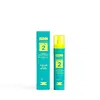What's inside
What's inside
 Key Ingredients
Key Ingredients

 Benefits
Benefits

 Concerns
Concerns

 Ingredients Side-by-side
Ingredients Side-by-side

Water
Skin ConditioningDimethicone
EmollientNiacinamide
SmoothingBetaine
HumectantLauryl PEG/PPG-18/18 Methicone
Skin ConditioningPropanediol
SolventSilica
AbrasiveDibutyl Adipate
EmollientAlcohol Denat.
AntimicrobialZinc PCA
Humectant1,2-Hexanediol
Skin ConditioningPentylene Glycol
Skin ConditioningCaprylyl Glycol
Emollient4-T-Butylcyclohexanol
MaskingSodium Acrylates Crosspolymer-2
AbsorbentPolyacrylate Crosspolymer-6
Emulsion StabilisingXylitol
HumectantCaprylic Acid
CleansingTocopheryl Acetate
AntioxidantSphingomonas Ferment Extract
Skin ConditioningCaprylic/Capric Triglyceride
MaskingGlycerin
HumectantHydroxyacetophenone
AntioxidantPentaerythrityl Tetra-Di-T-Butyl Hydroxyhydrocinnamate
AntioxidantParfum
MaskingMaltodextrin
AbsorbentBixa Orellana Seed Extract
MaskingHydrolyzed Opuntia Ficus-Indica Flower Extract
AbrasiveDisodium EDTA
Tocopherol
AntioxidantRetinal
Skin ConditioningSodium Hydroxide
BufferingPhospholipids
Skin ConditioningT-Butyl Alcohol
PerfumingCitral
PerfumingAscorbic Acid
AntioxidantWater, Dimethicone, Niacinamide, Betaine, Lauryl PEG/PPG-18/18 Methicone, Propanediol, Silica, Dibutyl Adipate, Alcohol Denat., Zinc PCA, 1,2-Hexanediol, Pentylene Glycol, Caprylyl Glycol, 4-T-Butylcyclohexanol, Sodium Acrylates Crosspolymer-2, Polyacrylate Crosspolymer-6, Xylitol, Caprylic Acid, Tocopheryl Acetate, Sphingomonas Ferment Extract, Caprylic/Capric Triglyceride, Glycerin, Hydroxyacetophenone, Pentaerythrityl Tetra-Di-T-Butyl Hydroxyhydrocinnamate, Parfum, Maltodextrin, Bixa Orellana Seed Extract, Hydrolyzed Opuntia Ficus-Indica Flower Extract, Disodium EDTA, Tocopherol, Retinal, Sodium Hydroxide, Phospholipids, T-Butyl Alcohol, Citral, Ascorbic Acid
Isoamyl Laurate
EmollientC15-19 Alkane
SolventMacadamia Integrifolia/Tetraphylla Seed Oil
EmollientCocos Nucifera Oil
MaskingCocoglycerides
EmollientCoco-Caprylate
EmollientSimmondsia Chinensis Seed Oil
EmollientCaprylic/Capric Triglyceride
MaskingCamellia Oleifera Seed Oil
Skin ConditioningBakuchiol
AntimicrobialTocopherol
AntioxidantHelianthus Annuus Seed Oil
EmollientCitronellol
PerfumingBenzyl Salicylate
PerfumingLimonene
PerfumingGeraniol
PerfumingEugenol
PerfumingLinalool
PerfumingParfum
MaskingIsoamyl Laurate, C15-19 Alkane, Macadamia Integrifolia/Tetraphylla Seed Oil, Cocos Nucifera Oil, Cocoglycerides, Coco-Caprylate, Simmondsia Chinensis Seed Oil, Caprylic/Capric Triglyceride, Camellia Oleifera Seed Oil, Bakuchiol, Tocopherol, Helianthus Annuus Seed Oil, Citronellol, Benzyl Salicylate, Limonene, Geraniol, Eugenol, Linalool, Parfum
 Reviews
Reviews

Ingredients Explained
These ingredients are found in both products.
Ingredients higher up in an ingredient list are typically present in a larger amount.
This ingredient is an emollient, solvent, and texture enhancer. It is considered a skin-softener by helping the skin prevent moisture loss.
It helps thicken a product's formula and makes it easier to spread by dissolving clumping compounds.
Caprylic Triglyceride is made by combining glycerin with coconut oil, forming a clear liquid.
While there is an assumption Caprylic Triglyceride can clog pores due to it being derived from coconut oil, there is no research supporting this.
Learn more about Caprylic/Capric TriglycerideParfum is a catch-all term for an ingredient or more that is used to give a scent to products.
Also called "fragrance", this ingredient can be a blend of hundreds of chemicals or plant oils. This means every product with "fragrance" or "parfum" in the ingredients list is a different mixture.
For instance, Habanolide is a proprietary trade name for a specific aroma chemical. When used as a fragrance ingredient in cosmetics, most aroma chemicals fall under the broad labeling category of “FRAGRANCE” or “PARFUM” according to EU and US regulations.
The term 'parfum' or 'fragrance' is not regulated in many countries. In many cases, it is up to the brand to define this term.
For instance, many brands choose to label themselves as "fragrance-free" because they are not using synthetic fragrances. However, their products may still contain ingredients such as essential oils that are considered a fragrance by INCI standards.
One example is Calendula flower extract. Calendula is an essential oil that still imparts a scent or 'fragrance'.
Depending on the blend, the ingredients in the mixture can cause allergies and sensitivities on the skin. Some ingredients that are known EU allergens include linalool and citronellol.
Parfum can also be used to mask or cover an unpleasant scent.
The bottom line is: not all fragrances/parfum/ingredients are created equally. If you are worried about fragrances, we recommend taking a closer look at an ingredient. And of course, we always recommend speaking with a professional.
Learn more about ParfumTocopherol (also known as Vitamin E) is a common antioxidant used to help protect the skin from free-radicals and strengthen the skin barrier. It's also fat soluble - this means our skin is great at absorbing it.
Vitamin E also helps keep your natural skin lipids healthy. Your lipid skin barrier naturally consists of lipids, ceramides, and fatty acids. Vitamin E offers extra protection for your skin’s lipid barrier, keeping your skin healthy and nourished.
Another benefit is a bit of UV protection. Vitamin E helps reduce the damage caused by UVB rays. (It should not replace your sunscreen). Combining it with Vitamin C can decrease sunburned cells and hyperpigmentation after UV exposure.
You might have noticed Vitamin E + C often paired together. This is because it is great at stabilizing Vitamin C. Using the two together helps increase the effectiveness of both ingredients.
There are often claims that Vitamin E can reduce/prevent scarring, but these claims haven't been confirmed by scientific research.
Learn more about Tocopherol